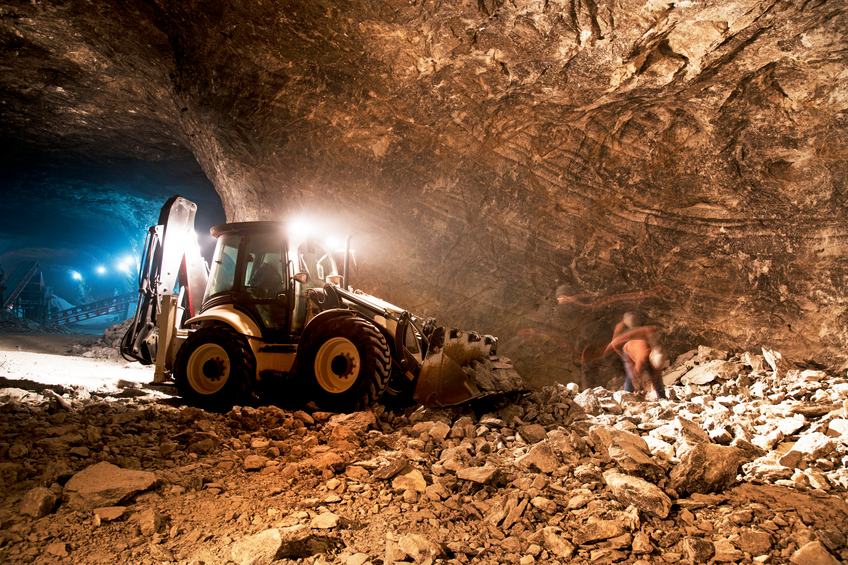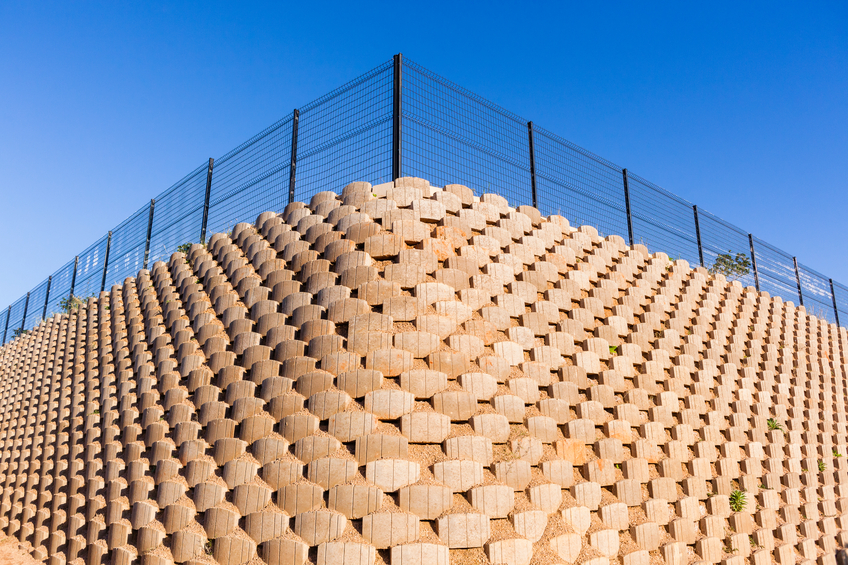Foundation Engineering 12 PDH Discount Package
An Introduction to Deep Foundations (G02-007)
An Introduction to Excavation for Structures (G02-002)
An Introduction to Pile Foundations for Structures (G02-003)
An Introduction to Retaining Walls and Excavation Support Systems (G02-006)
An Introduction to Spread Footings and Mat Foundations (G02-008)

This online engineering PDH course will introduce you to shear strength parameters, tension forces and methods for analysis of soils and rock to determine load bearing capacity.
Stresses transmitted by a foundation to underlying soils must not cause bearing-capacity failure or excessive foundation settlement. The design bearing pressure equals the ultimate bearing capacity divided by a suitable factor of safety. The ultimate bearing capacity is the loading intensity that causes failure and lateral displacement of foundation materials and rapid settlement. The ultimate bearing capacity depends on the size and shape of the loaded area, the depth of the loaded area below the ground surface, groundwater conditions, the type and strength of foundation materials, and the manner in which the load is applied.
This 2 PDH online course is intended for civil engineers, structural engineers, geotechnical engineers, geologists and other design and construction professionals seeking an introduction to methods for analysis of soils and rock to determine load bearing capacity.
This PE continuing education course is intended to provide you with the following specific knowledge and skills:
- Learning about the shear strength parameters involved in bearing capacity analysis
- Learning the different bearing capacity analysis techniques to use for cohesive and cohesionless soils
- Learning how to address groundwater in analysis of soils for load bearing capacity
- Learning how to determine the ultimate bearing capacity of soils and rock for all combinations of simultaneous loads
- Learning about methods of analysis for deep foundations in stratified soils
In this professional engineering CEU course, you need to review the course document titled, "An Introduction to Bearing Capacity Analysis".
Upon successful completion of the quiz, print your Certificate of Completion instantly. (Note: if you are paying by check or money order, you will be able to print it after we receive your payment.) For your convenience, we will also email it to you. Please note that you can log in to your account at any time to access and print your Certificate of Completion.

This online engineering PDH course will provide you with an introduction to methods for analysis and design of deep foundations. It discusses problems of placing footings and mats in deep excavations and design of drilled piers.
A deep foundation derives its support from competent strata at significant depths below the surface or, alternatively, has a depth to diameter ratio greater than 4. A deep foundation is used in lieu of a shallow foundation when adequate bearing capacity or tolerable settlements cannot be obtained with a shallow foundation. The term deep foundation includes piles, piers, or caissons, as well as footings or mats set into a deep excavation.
Drilled piers (or caissons) are simply large-diameter piles, but the design process is somewhat different. An arbitrary distinction between a caisson and pier is that the caisson is 30 inches or more in diameter.
This 2 PDH online course is intended for civil engineers, structural engineers, geotechnical engineers, geologists and other design and construction professionals wanting an introduction to deep foundations for buildings and other structures.
This PE continuing education course is intended to provide you with the following specific knowledge and skills:
- Learning the definition and design considerations applicable to floating foundations
- Learning the mechanics of settlement of compensated foundations
- Understanding when there is a likelihood of bearing capacity failure
- Learning about two commonly used procedures to mitigate bottom heave
- Learning about settlement issues adjacent to excavations
In this professional engineering CEU course, you need to review the course document titled, "An Introduction to Deep Foundations".
Upon successful completion of the quiz, print your Certificate of Completion instantly. (Note: if you are paying by check or money order, you will be able to print it after we receive your payment.) For your convenience, we will also email it to you. Please note that you can log in to your account at any time to access and print your Certificate of Completion.

This online engineering PDH course is an introduction to the methods of evaluating the stability of shallow and deep excavations. You will learn about the two basic types of excavations: "open excavations" where stability is achieved by providing stable side slopes, and "braced excavations" where vertical or sloped sides are maintained with protective structural systems that can be restrained laterally by internal or external structural elements. You will be introduced to the methodology for selecting and designing excavation systems including consideration of soil type and strength parameters, groundwater conditions, slope protection, side and bottom stability, vertical and lateral movements of adjacent areas, and effects on existing structures.
This 2 PDH online course is intended for civil, structural and geotechnical engineers and other design and construction professionals interested to learn the fundamentals of excavation in soils for stability and safety, as they relate to open cut excavations, trenching, rock excavation, excavation stabilization and safety, embankment cross-section design, and borrow excavation.
This PE continuing education course is intended to provide you with the following specific knowledge and skills:
- Learning about sloped and vertical open excavation cuts
- Learning about the principal factors influencing trench stability
- Understanding the primary considerations for slope design in different soil types
- Learning about the two excavation types: "open excavations" and "braced excavations"
- Learning about trench excavation support systems
In this professional engineering CEU course, you need to review the course document titled, "An Introduction to Excavation for Structures".
Upon successful completion of the quiz, print your Certificate of Completion instantly. (Note: if you are paying by check or money order, you will be able to print it after we receive your payment.) For your convenience, we will also email it to you. Please note that you can log in to your account at any time to access and print your Certificate of Completion.

This online engineering PDH course is an introduction to data, principles, and methods for use in planning, design, and construction of deep foundations. Deep foundations are braced column elements (piles) transmitting structure loads down to the subgrade supporting medium. This course provides an introduction and general information with respect to the selection and design of deep foundations. Single and groups of driven piles and drilled shafts under axial and lateral static loads are treated.
This 2 PDH online course is intended for civil, structural and geotechnical engineers and other design and construction professionals interested in learning the types and application of timber, steel and concrete piles for foundations of structures.
This PE continuing education course is intended to provide you with the following specific knowledge and skills:
- Understanding the general methodology for pile selection and design
- Learning about the "Load Factor Design (LFD)" approach
- Learning how to apply the "Global Safety Factor (FS)"
- Knowing how to address special situations when expansive clays, coral sands, and/or unconsolidated soils are encountered
- Learning about large, small and non-displacement pile systems
- Understanding the characteristics of timber, precast, Raymond and steel piles
In this professional engineering CEU course, you need to review the course document titled, "An Introduction to Pile Foundations for Structures".
Upon successful completion of the quiz, print your Certificate of Completion instantly. (Note: if you are paying by check or money order, you will be able to print it after we receive your payment.) For your convenience, we will also email it to you. Please note that you can log in to your account at any time to access and print your Certificate of Completion.

This online engineering PDH course presents methods for evaluating earth pressures on retaining walls and design procedures for cohesionless backfill materials, which should be used whenever practicable.
Retaining walls must be designed so that foundation pressures do not exceed allowable bearing pressures, wall settlements are tolerable, safety factors against sliding and overturning are adequate, and the wall possesses adequate structural strength.
This 2 PDH online course is intended for civil engineers, structural engineers, geotechnical engineers, geologists and other design and construction professionals seeking an introduction to methods and techniques designing retaining walls and excavation support structures.
This PE continuing education course is intended to provide you with the following specific knowledge and skills:
- Understanding the types of forces acting on retaining walls
- Learning about active and passive earth pressures
- Learning how to design for surcharge and dynamic loads on retaining walls
- Learning how to apply the equivalent fluid pressure method in retaining wall design
- Knowing the criteria for selecting earth pressures as the basis of retaining wall design
- Knowing the importance of designing for overturning forces acting on retaining walls
- Learning how to design for sliding forces acting on retaining walls
In this professional engineering CEU course, you need to review the course document titled, "An Introduction to Retaining Walls and Excavation Support Systems".
Upon successful completion of the quiz, print your Certificate of Completion instantly. (Note: if you are paying by check or money order, you will be able to print it after we receive your payment.) For your convenience, we will also email it to you. Please note that you can log in to your account at any time to access and print your Certificate of Completion.

This online engineering PDH course provides an introduction to the design of spread footings and mat foundations for buildings and other structures such as towers on cohesive and cohesionless soils.
When required footings cover more than half the area beneath a structure, it is often desirable to enlarge and combine the footings to cover the entire area. This type of foundation is called a raft or mat foundation and may be cheaper than individual footings because of reduced forming costs and simpler excavation procedures. A mat foundation also may be used to resist hydrostatic pressures or to bridge over small, soft spots in the soil, provided the mat is adequately reinforced.
This 2 PDH online course is intended for civil engineers, structural engineers, geotechnical engineers, geologists and other design and construction professionals seeking an introduction to methods and techniques for designing footings and mat foundations for buildings and other structures such as towers.
This PE continuing education course is intended to provide you with the following specific knowledge and skills:
- Understanding the guidelines for depth of foundations
- Learning how to design footings in cohesive soils
- Learning about design of footings in cohesionless soils such as sand
- Learning how to estimate foundation pressures distribution
- Learning how to design for stability of mat foundations
- Knowing the conventional and approximate plate methods of analysis of mat foundations
- Learning how to design mat foundations on compressible soils
In this professional engineering CEU course, you need to review the course document titled, "An Introduction to Spread Footings and Mat Foundations".
Upon successful completion of the quiz, print your Certificate of Completion instantly. (Note: if you are paying by check or money order, you will be able to print it after we receive your payment.) For your convenience, we will also email it to you. Please note that you can log in to your account at any time to access and print your Certificate of Completion.